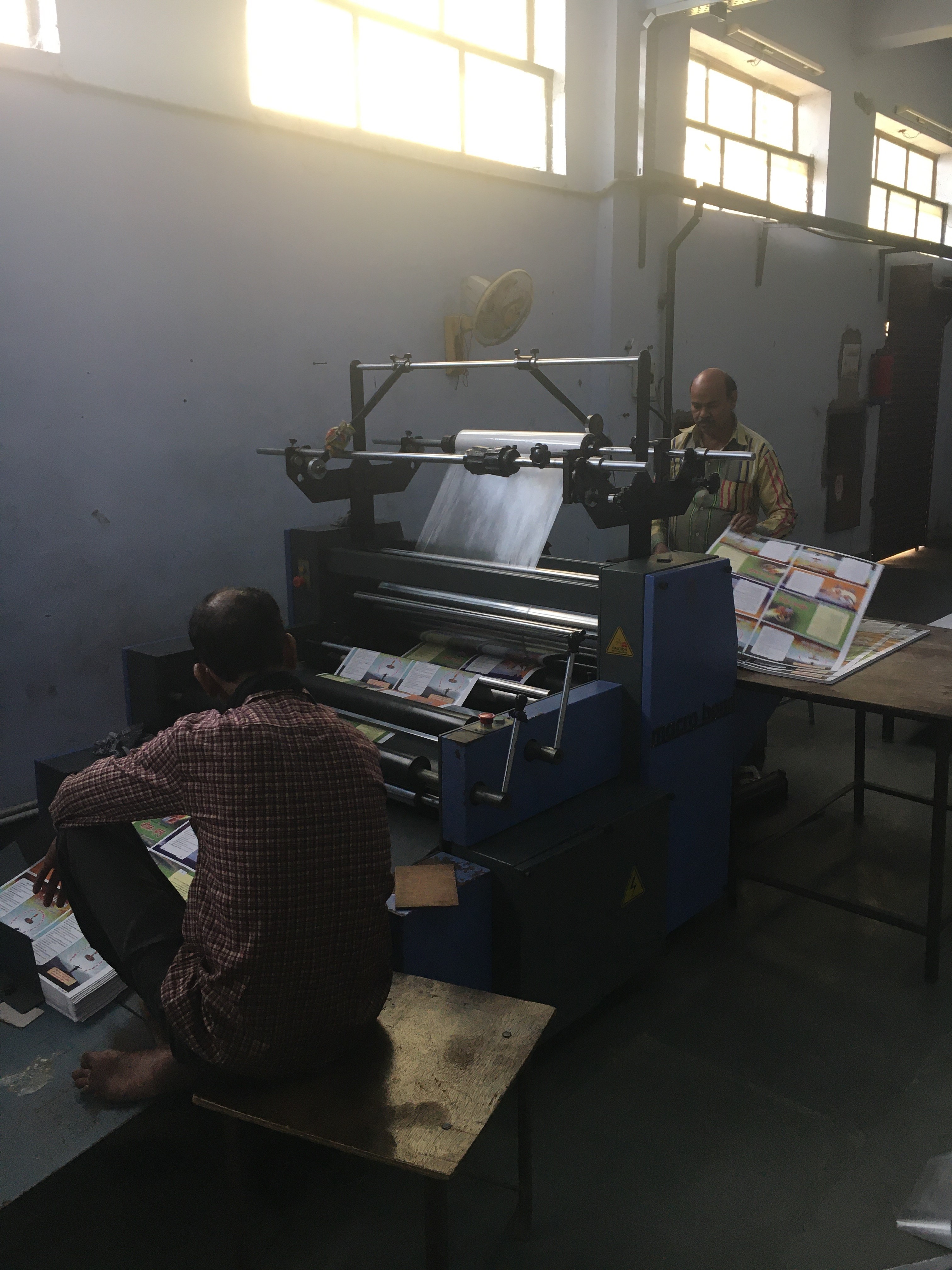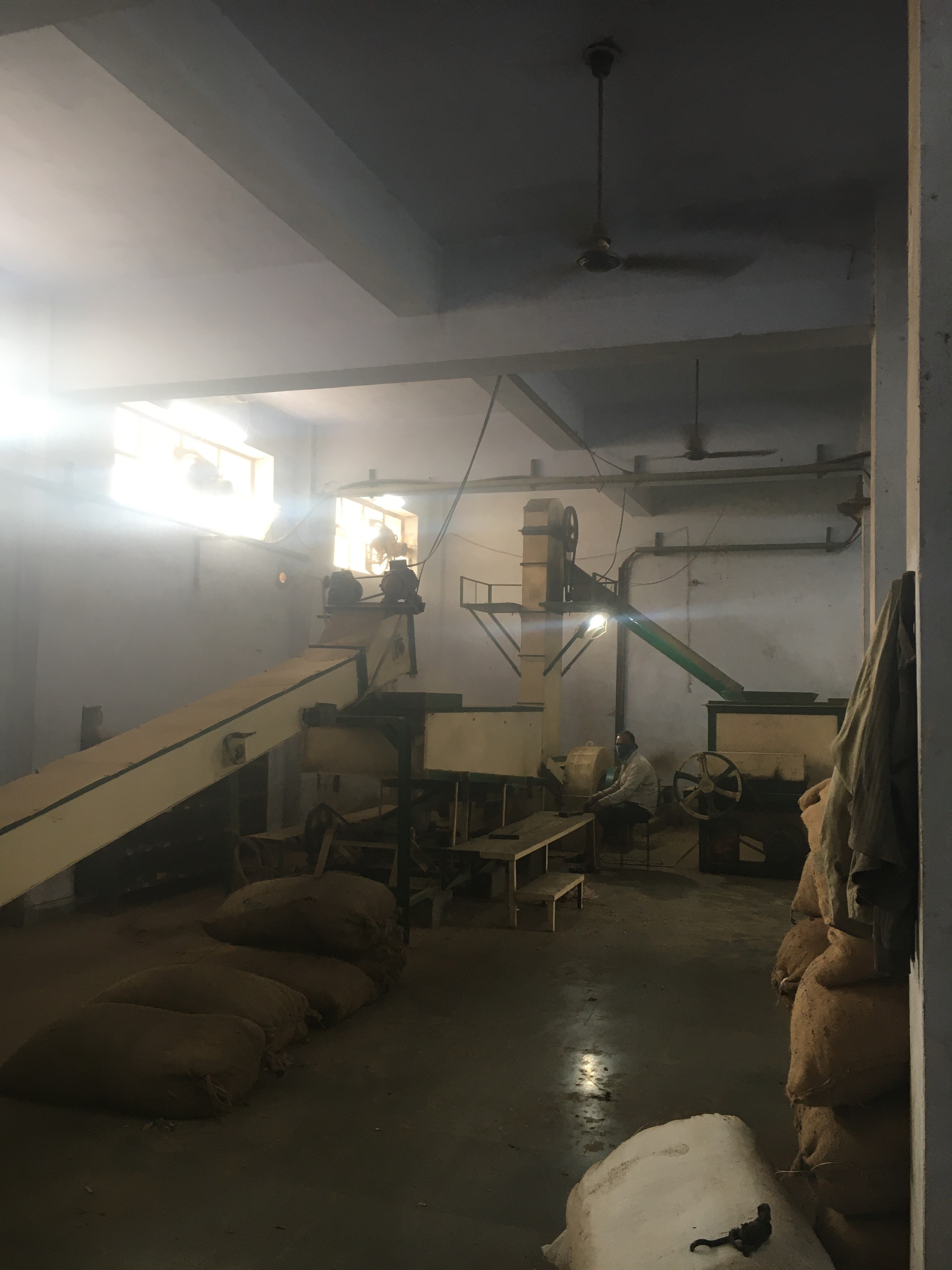Gayatri Press
Gayatri Pariwar
There are actually two Gayatri Pariwar operated presses in Mathura. The smaller of the two, located across the street from the police checkpoint south of the Birla Mandir, is responsible for the publication of the Akhaṇḍ Jyoti magazine, the headquarters of which are located in Giya Mandi, a neighborhood several kilometers south of the Gayatri Tapobhumi. The larger of the two presses lies on the plot immediately north of the Birla Mandir, and the grounds contain not only facilities for the publication and inventory of most of the organization’s print materials, but also lodging for nearly five hundred pilgrims. A second residential structure is within a year of completion, which will double the number of visitors able to stay on the press grounds.
Until very recently, neither press location was visibly identifiable from the roadside, but a bright red signboard reading “Yug Nirman Yojna Trust” now stands outside the entrance of the larger press. Yet only those who already know of the organization and its publications are likely able to infer the Gayatri Pariwar from the name of the trust.
Press Building
The press facility is a four-story building and houses the production of most of the Gayatri Pariwar’s print materials, as well as a few other items such as havan samāgrī. The organization of the building reflects the publication process: materials are printed on the ground floor, bound on the second floor, and inventoried on the third and fourth floors. The third floor is also where inventoried items are packaged for distribution. Although every employee operating machinery was male, several female employees sat on the second floor collating printed materials for binding and sorting bound materials for storage and/or packaging.
The havan sāmagrī is processed on the ground floor, further back than the printing facilities. The room where it happens is filled with gunny sacks, some with unprocessed seeds, leaves, and nuts, and others with the finely-ground sāmagrī for use in daily yajña. Aside from these sacks, two large mechanical apparatuses fill the space. The first extends the length of the far side of the room: a hole in the ground allows a conveyor belt to carry unprocessed mulch into a grinder, which then deposits the mixture into a large basin attached to a piston that shakes the basin so that the sāmagrī is evenly distributed.
A second machine either grinds the herbs further or filters them in some way. Four workers, all men, operate the machinery. Two shoveled loose mulch onto the conveyor belt, one sat by the basin ensuring that the processing went smoothly, and a fourth used a power tool that to seal the gunny sacks filled with processed sāmagrī.
Laborer’s Tenements
Directly across from the backside of press factory building is the home of Janardan Maurya, who is the senior administrator of printing and distribution of the Bharatiya Sanskriti Gyan Pariksha. The lane between these buildings is approximately twenty feet wide, three feet of which consist of a shallow sewer covered by clapboards. The remaining space accommodates a row of around twenty one-room structures of loosely assembled bricks covered with corrugated metal roofs. This is the housing allotted to the service class in residence – sweepers, washers, and the like (naukrānī) – responsible for the cleaning and maintenance of the pilgrim lodgings and other structures on the press grounds. The laborers hired to complete the construction of the new goshālā and residential building likely also make use of these makeshift homes.
Were I not led into this alleyway by the receptionist of the press in a search for Janardan Maurya at home, I would likely never have seen this hidden strip of labor class dwellings. The receptionist who led me to the area casually pointed the structures out to me, which suggests he felt that the separate lodging of a service staff in such accommodations is normal. To clarify, those who live in these dwellings likely work contractually for the Gayatri Pariwar, and are not likely to belong to the Gayatri Pariwar community. A laborer responsible clearing debris from the new construction site told me that neither he nor many of the construction workers have any connection to the Gayatri Pariwar outside of their labor contracts. Despite a heavy emphasis on caste inclusion in the organization’s literature and historical narrative, these labor tenements are one of several places where a clear demarcation of caste and class difference in Gayatri Pariwar spaces is visible (should you have the chance to look).
New Goshala and Pilgrim Lodgings
The structural work is nearly complete for a four-story building located on the southwestern corner of the Gayatri Pariwar Press grounds, but the interior work is very much under way. The sounds of power tools echoed through the concrete structure as I stood outside the entryway waiting for the foreman, Anand Sharma. After some time, a broad-shouldered man in a tan handloom kurta, crisp white bottoms, and polished dress shoes descended the stairs – silver roots betrayed a mustache dyed black. Anand Sharma is a civil engineer by profession, and he worked with the Birla Temple next door until 1997, from which time he has taken over work on the Gayatri Pariwar’s construction projects. The son-in-law of Mrtyunjaya Sharma (the president of the Gayatri Pariwar’s Yug Nirman Yojna Vistar Trust and son-in-law of the organization’s founder, Shriram Sharma), Anand Sharma carries a lot of sway in the Gayatri Pariwar.
According to the foreman, there are over one-hundred and fifty rooms being built in this new structure, which will add an additional five-hundred to six-hundred person capacity to the grounds, thereby doubling the number of visitors that can stay onsite. These rooms will take up the top three stories of the building. On the ground floor, a new goshālā was formally opened on October 8th. Although the cows graze out front until 4:00 p.m. every day, they are brought in and milked in the evening. The back of the goshālā contains the area where cow byproducts are processed. The Gayatri Pariwar makes use of all of the cow byproducts. Milk and ghee are used at the Tapobhumi cafeteria, whereas cow urine and feces are used in the chikitsālaya and yajñashālā, respectively. Below the goshālā, and also still under construction, is where the cow feed will be stored. Somewhere in this structure, likely on one of the residential floors, a naturopathic clinic is also under construction. Construction on this building will not take longer than another year.


